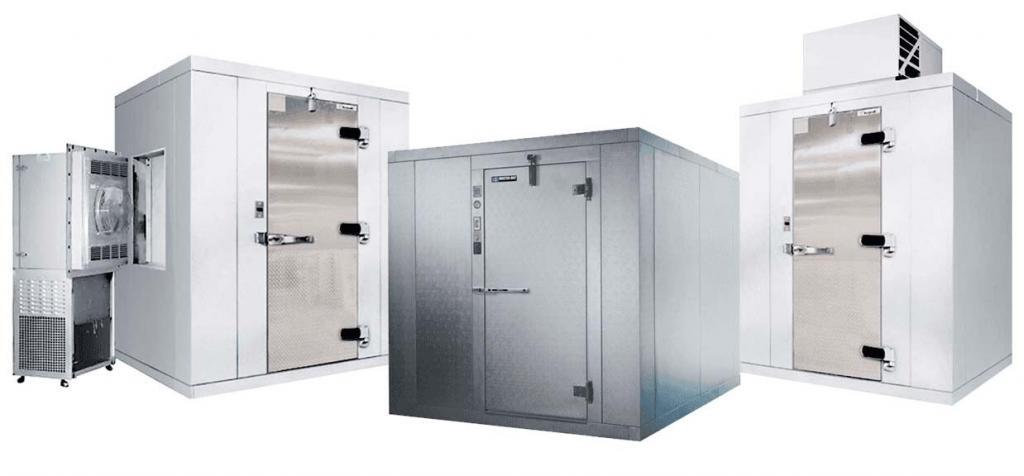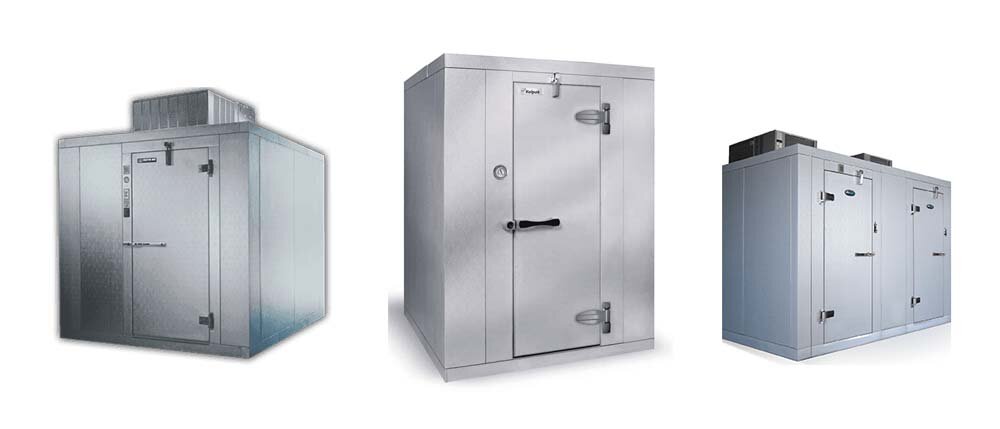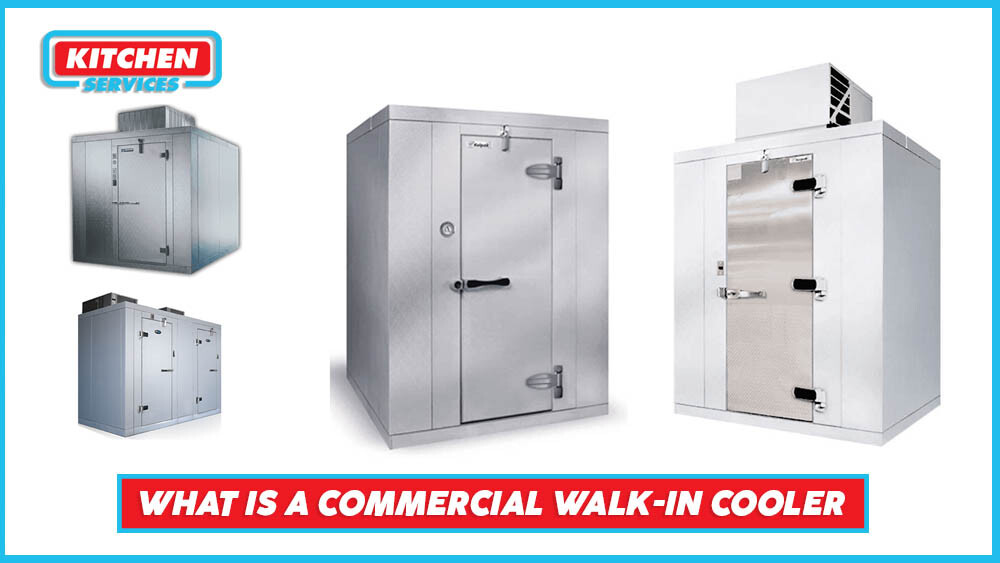In a top-notch food store or a big restaurant, ever wonder what are those big refrigerator-like machines that carry divergent sets of drinks and foods within them like a room? Those are walk-in coolers. The basic purpose of a walk-in cooler is to preserve big chunks of food that are prone to perish at room temperature. Unlike the refrigerator, the walk-in cooler has an enormous structure that you could actually walk into it in order to get food out or store it in the cooler.
Usually, walk-in coolers are made with metals alongside panels of foam insulation. It is slightly different than a regular refrigerator because many different panels configurations and cam options are available in it which in the case of the refrigerator are unthinkable.
As modern kitchen services, we often face questions like what exactly a commercial walk-in cooler is and what are its benefits and types. Upon doing research we are writing this one-time guide for you to walk-in coolers.
Types Of Commercial Walk-In Cooler

- Prefabricated Walk-In Cooler
- Built-In Walk-In Cooler
To store shards of food and beverages a walk-in cooler is the best solution. To maintain the standard and versatility of the product many companies focused on Prefabricated coolers. It’s a type of walk-in cooler that is prebuilt with standard dimensions and configuration options. And the other type is a built-in cooler that is built specifically on requirements. Like if you need a walk-in cooler for your food store and you want it for a specific place with limited customization options then a built-in cooler is very much suited to you.
Components of a walk-in cooler
Now let’s talk about the components of a walk-in cooler.
Panels
The skin of a walk-in cooler is made up of aluminum, stainless steel, or sometimes galvanized steel. Its merely like a refrigerator constructed of foam insulation between steel materials mentioned above. The insulation foam used in walk-in coolers is 4 inches thick to prevent environmental factors thus making it efficient against temperature loss and energy consumption. The insulation foam is highly dense known as polyurethane that has a high R-value.
Door
In a walk-in cooler, the door is frequently used thereby it has to be strong and tight sealed to bear the usage up to a higher degree. The door of a walk-in cooler should have adjustable hinges to ensure a tight seal for quality energy saving. The self-closing doors are preferable to the ordinary doors because you don’t have to worry about closing it all the time when you go through or out of them. Self-closing doors are available both in prefabricated walk-in coolers and built-in walk-in coolers.
Floor
In a fancy restaurant, a walk-in cooler is more often used as compared to the food stores. The floor is dependable on your requirements and anticipated traffic. Most of the time the floor of a walk-in cooler is made up of smooth aluminum that is satisfactory with minimal traffic but if you have tremendous usage like a restaurant then you should go for a heavy-duty floor. Many manufacturers are giving advanced flooring options as per customer’s requirements. Although many companies don’t offer the walk-in cooler with a floor however if you go with a floor walk-in cooler then the outcome would be more reliable and neat as compared to the ones which don’t have floor option, it helps in terms of proper isolation which is advantageous against losing temperature and environmental factors.
Walk-In Kitchen Range Refrigeration Systems

The placement of your refrigeration system depends on several factors, such as the size of your space, and building requirements so you can utilize the performance at its maximum. There are three mounting options for your refrigeration system: top mount, side mount, and remote. No matter which option you choose, it is recommended to have a qualified technician come to install your refrigeration system to ensure it is installed properly either it’s a prefabricated system or a built-in walk-in cooler.
Top-Mount:
Top-mounted refrigeration systems are self-contained and pre-assembled, so these units are ready to go out of the box with standardized customization capacities. Some manufacturers design refrigeration systems to be flush to the interior so that the evaporator coil doesn’t infringe on the usable interior space of the walk-in in most cases. When used on indoor walk-ins, heat is discharged from the compressor, which can create added stress on your HVAC to prevent the heat from causing any damage to the interior of the walk-in cooler.
Side Mount:
Side mount systems have many similarities to top-mounted systems, but are bolted onto the sidewall of the walk-in. Side mount is an option when you have a low ceiling that won’t fit a top mount. However, because of the location of the system, interior shelf space can be reduced due to the location of the evaporator coil. However, the functionalities are the same along with heat discharging from the compressor to avoid heat damages but the only difference is of structural concern.
Remote:
Remote systems are less expensive than the top or side-mounted systems. They are designed to sit outside of the building, which helps in situations where space is needed for ventilation of your walk-in refrigerator. A remote walk-in is also served as a top and side mount refrigerator system moreover the difference is it doesn’t occupy any unnecessary space and ventilation is placed outside the building.
Contact us for specialized Walk in cooler installation service for Restaurants
Things To Consider Before Buying A Walk-In Cooler
In addition to what we’ve already discussed above, there are some important considerations to make when choosing a walk-in refrigerator or walk-in freezer given below.
Freezer or Refrigerator:
The first thing you need to know is whether you will need a walk-in refrigerator or a walk-in freezer because they both are different things. It all depends on whether you rely mostly on fresh ingredients like a restaurant or the frozen ingredients like a food store. Walk-in coolers hold below 41 degrees Fahrenheit, while walk-in freezers hold around 0 degrees Fahrenheit. If you have the room and need solutions for both fresh and frozen foods, most manufacturers will carry two-compartment walk-ins that allow you to have one section as a cooler and the other as a freezer like an ordinary refrigerator system but in walk-in form.
Indoor or Outdoor:
It’s very important to understand that there is a difference between an indoor and an outdoor walk-in, they are usually differentiated by the manufacturer as well. If using in an outdoor application, then the walk-in will come with panels for a roof for isolation purposes which of course will mean that you will most likely pay more for an outdoor walk-in. However, outdoor models will typically have thicker insulation as compared to indoor walk-ins as well as an outdoor roof sealing kit to keep the unit protected from the elements and environmental concerns.
Size:
One of the first things you need to decide on when purchasing a walk-in cooler or freezer is what size box do you need? This will depend on several factors, given below the table can serve as a general guideline.
| Operation Type | Number of Walk-Ins | Total Square Feet |
| Fast Food Restaurant | 1 | 90 – 120 |
| Small Table Service Restaurant | 1 | 120 – 150 |
| Medium Restaurant or Small Institution | 2 | 180 – 240 |
| Large Restaurant or Medium Institution | 3 | 240 – 400 |
| Large Institution | 3 | 400 – 600 |
| Large Hotel, Restaurant, or Institution, with a Complex Menu and Catering Facilities | 4 | 600 – 900 |
However, you can customize the size if you are going off a built-in walk-in system that is supposed to install as per given specific details.
Cooling:
For a walk-in to operate effectively and efficiently you need to ensure that it has enough space to allow for proper air circulation (In and Out). Your walk-in should have a minimum of 1 inch of space between the exterior of the walk-in and the walls and ceilings of your building to allow the proper exhaustion. If using a top-mounted compressor, a minimum of 2 inches of space should be allowed from the top of the compressor and the ceiling recommended by the technicians.
Installation:
When dealing with a large piece of equipment such as a walk-in, you will need to make sure that your space is ready when the unit is delivered for a quick and smooth installation. Make sure that your technician is an expert in the installation of the cooler. Clear the space before the delivery day so that the cooler reached the selected place easily.
Warranty:
We don’t like to think about it but sometimes equipment fails because of many random reasons. Having a strong warranty for your walk-in should absolutely be considered before you purchase to avoid problems in the future. Manufacturer warranties vary, so be sure you know what the warranty is before you buy to prevent yourself from any headaches.
Maintenance:
Cleaning your walk-in cooler or freezer is relatively easy just like the regular refrigerator. Most manufacturers recommend cleaning simply with warm soapy water using a damp, not wet, mop.
In addition to surface cleaning, you should clean your condenser a minimum of once every three months. Avoid using hard items to clean stuff because it could damage the skin. The efficiency of the condensing unit depends on unrestricted airflow through the condenser. Make sure you clean the walk-in with soft items and have sophisticated room for air circulation.
Benefits of Having a Walk-In Cooler
No matter for what purpose you are buying a walk-in cooler it is always a great investment, so it is very important that you are very well informed about the walk-in cooler that you are choosing for yourself. A walk-in cooler is much larger than a standard cooler, which makes it perfect for large food storing purposes. Keep in mind that the size of the walk-in cooler you are going for is equivalent to the number of meals you are planning to serve daily in your commercial kitchen. Walk-in coolers are available in a wide range of styles, sizes as well as designs, but here are a few of the key benefits you can expect from a walk-in cooler.
Energy Saving
Many people think that a walk-in cooler costs a lot to power, but the fact is although it can be a major expense still the cost to power of a walk-in cooler is very much much less than the shared cost to power several individual standard size refrigerators. Additionally, in case you have an industrial-grade walk-in cooler, all the inside components are designed in such a way that they work a lot better and much more effectively than any of the basic consumer coolers. There are also many ways that you can reduce the operating costs, such as equipping the cooler with quality insulation or installing walk-in curtains in your cooler. You may also minimize energy costs in such a way that you provide regular maintenance like routine checking the gaskets and door sweeps for wear and replacing them whenever required.
Expanding storage capacity
No matter wherever you work whether it is a restaurant or any catering or retail industry having some extra storage will always be preferred. Walk-in chillers usually allow these sorts of industries to store a different variety of products and open to new opportunities that can definitely affect business sales. This extra storage will not only be used to store long-life products, but it can also be used in order to test out many new products on a very short-term purpose. Obviously walk-in chillers can provide extra storage to industries either externally or internally. This is a plus point for all those companies that are restricted on space, because of the reason that all these products can be placed externally.
Improved Access
Because of the reason that cold rooms are basically required for everyday use within all the industries whether it is catering or retail, making sure that you have easy access is very important. The improved access of the walk-in chiller will always allow companies to take advantage of increased storage, to have more productivity and efficiency because of the reason that products can be easily accessed by any member of staff.
Stock rotation
Walk in freezers can help in reducing a lot of your cost. For instance, we know that walk-in freezers are to be used in order to store a large quantity of products all year round although if we focus on stock rotation.
Walk-in coolers would also allow many industries to make sure that they do not have foods over their use-by date, therefore fulfilling all the health and safety regulations. These walk-in coolers help in keeping a lot of products at an optimum level to keep them attractive for their consumers and it can also prevent a loss of waste and help in increasing profit margins as well.
Efficiency & Even Temperature Control
Commercial Walk-in coolers tend to easily adapt in order to suit all the needs and major requirements for your industry. No matter what you are storing in the fridge whether it be storing meat, fish or any dairy product, the temperature can be adjusted in order to suit the products that are being stored. The even temperature control prevents cold air from escaping the storage and therefore it offers you peace of mind that products are safely put in the cooler.
Meeting health and safety guidelines is very important when you are dealing with products such as food mainly. However, even temperature control would make sure that temperature is kept balanced always. Furthermore, if temperature reaches an unsafe level, your team will be warned.
Deep Freeze Temperature Range
Companies that are working within the food industry will always have some temperature restrictions that they always have to follow no matter what. These walk-in coolers would always offer the advantage of a deep freeze temperature range. This would allow all the products to be stored at -18° Celsius or below and be maintained at an ideal condition.
All the products are different so there are chances that some of the products may be more sensitive to temperature as compared to others, so storage at the correct temperature is critical. The temperature range of commercial walk-in cooler will also prevent any sort of freezer burn and it will also slow down weakening of products.
Temperature Guidelines for Commercial Walk-in Cooler
Flexibility
Another great advantage of a walk-in cooler is that a range of food can be safely stored while minimizing the risk of bacterial growth. The deep freezer temperature range offers products to be quickly cooled from 70˚C to 3˚C and in a period of 90 minutes. As a result, all those industries that are dealing with the storage of food can safely chill or freeze ingredients to use later.
Maintenance
One of the best benefits of a walk-in cooler is its size, but not to forget the other great benefit is the ease in terms of installation. All these cooler units can be installed directly on top of a solid concrete floor, and there is no need to install specialized flooring for its installation.
Preservation Types
Commercial Walk-in cooler are built in standard sizes, but they can also be customized or built into kitchens and supermarkets according to the references. They can also be placed inside or outside a building that is built with or without floors and may contain in-place or remote condensers also.
Standard Features
Commercial Walk-in cooler are also available with self-contained refrigeration systems where the evaporator coil and compressor are mounted together on a frame that are interconnected with pre-charged refrigerant lines and mounted on a ceiling or sidewall.
Exclusive Technology
Commercial Walk-in cooler have an air circulation system which can allow them to draw in cold outside air when the exterior temperature is comparatively colder than the interior temperature which is available to increase a unit’s compressor. Another option that is available is the pressure relief valve that is designed to reduce the slight vacuum which is created when warmer air enters a walk-in and expands when the door is closed, which can make it difficult for staff to open a unit.
Footprint
Manufactured walk-in coolers start around 5′ x 6′. Any of the outdoor cold storage boxes can be built to fit in any foodservice operation that your storage space requires.
Capacity
Your commercial walk-in cooler can allow 1 cubic foot of open storage area to accommodate 28 lbs of solid food product.
Energy Source
Small walk-in coolers commonly include a 1/2 hp compressor to maintain 35°F. Walk-in freezers have a 1-hp compressor to maintain a -10°F box temperature. Single-phase 115 volts can power small models, but most units require single-phase 208/230 volts.
Construction
Most of the walk-in boxes are made up of prefabricated panels that also have urethane insulation sandwiched between aluminum or stainless steel. All manufacturers rate insulation with an “R-value”- most panels are rated around R-30, which requires about 4′ of insulation. Panels are mass-produced in standard widths of 1′, 2′ and 4′, and heights of 7 1/2′, 8 1/2′ and 9 1/2′.
Types of Commercial Walk-In Cooler FAQs
What are the accessories of a commercial walk-in cooler?
You can use the following accessories for your walk-in cooler.
Strip Curtains
If your operation requires frequent opening and closing of your walk-in door like in a restaurant then strip curtains are an ultimate solution for maintaining the temperature and save energy. Strip curtains are strips of PVC vinyl that hang just in front of your door. They block cold air from escaping the walk-in and avoid outer air to come in, keeping your refrigerated or frozen product safe.
Shelving
Incorporating shelving inside your walk-in will only increase the available square footage of the unit. Shelving units keep food off of the floor and allow air to circulate around the product like the ordinary refrigerator except it creates a whole lot of room inside the cooler.
Does my walk-in cooler or freezer need a floor?
Commercial Walk-in coolers are best installed on a level concrete floor. If your walk-in is installed on a wooden floor you must install an insulated floor along with it. Some health departments require specific finishes for your walk-in’s flooring so it is best to check with local health codes before installation.
How to decide the size of my Walk-in Cooler?
Walk-in refrigerators and freezers are much larger than reach-ins. The smallest units, sometimes called step-in units, typically occupy 15 cu. ft., while the customizable walk-ins can go as large as 400,000 sq. ft. A useful way to measure how big of a walk-in you need, is to look at how much food you need to store. The rule of thumb is every 1 sq. ft. of storage space can fit approximately 28 lbs. of solid food. If you have 50 lbs. of chicken to store, you’ll need to set aside around 1.8 cu. ft. of space in your walk-in for that.
Can I build my own walk-in cooler or freezer?
It may seem like a good way to save money by not having to pay for labor but we do not recommend building your own walk-in. It is not easy to install a walk-in if you have never done it before and you may not install it up to your local health departments required codes. Save yourself the trouble and have a professional install your walk-in.
How and when to clean Walk-in Cooler condensing unit?
Once a month, shut the power off to the walk-in cooler condensing unit. You can now safely vacuum all of the dust and debris which may have accumulated. Reversing the air flow of a shop-vac or using compressed air to blow dust away tends to be more effective than vacuuming the walk-in cooler alone.
When should I change the door seals of my Walk-in Cooler?
The seals should be pliable and make a tight seal against the cabinet. If they should tear or become brittle with age, you might consider having them replaced. Generally, you’ll need to do this once a year, mainly depends upon your usage.
How do I know my walk-in cooler needs repair?
Following are the warning signs of a malfunctioning commercial cooler,
- Wet Floors
- Strange Odors
- Temperature Fluctuation
- Hot or Noisy motor
If you witness any of the above signs, you need to get your Walk-in Cooler checked before it costs you a fortune.
How to control Walk-in Cooler Odor?
Commercial walk-in coolers and freezers are a closed environment, so some odor is expected. Really bad smells or odors that linger after a complete cleanout are the ones you need to be concerned about. The first step is to walk in and take a visual inventory. Best case, you’ll find a spill that has been left undetected. A simple cleanup and a bowl of charcoal briquettes, baking soda, or fresh ground coffee may be all it takes to bring your walk-in back to normal. Worst case, you have a bigger issue caused by germs and bacteria; one that could possibly contaminate your inventory.
What are the different types of restaurant walk in coolers?
Restaurant walk-in coolers come in several types, each designed to meet different storage and operational needs:
- Reach-In Coolers: These are smaller, self-contained units often used for quick access to frequently used items. They come in various sizes and configurations, including single, double, or triple door models.
- Walk-In Coolers: Larger than reach-ins, these units offer ample space for bulk storage. They can be custom-built to fit the kitchen layout and are typically used for storing large quantities of ingredients and supplies.
- Modular Walk-In Coolers: These are pre-fabricated and can be easily assembled on-site. They offer flexibility in size and configuration, making them suitable for restaurants with specific space constraints.
- Built-In Walk-In Coolers: Designed to be integrated into the restaurant’s existing structure, these units are custom-built to fit a designated area, providing seamless integration with the kitchen design.
- Outdoor Walk-In Coolers: Suitable for restaurants with limited indoor space, these coolers are designed for outdoor use and are built to withstand various weather conditions.

